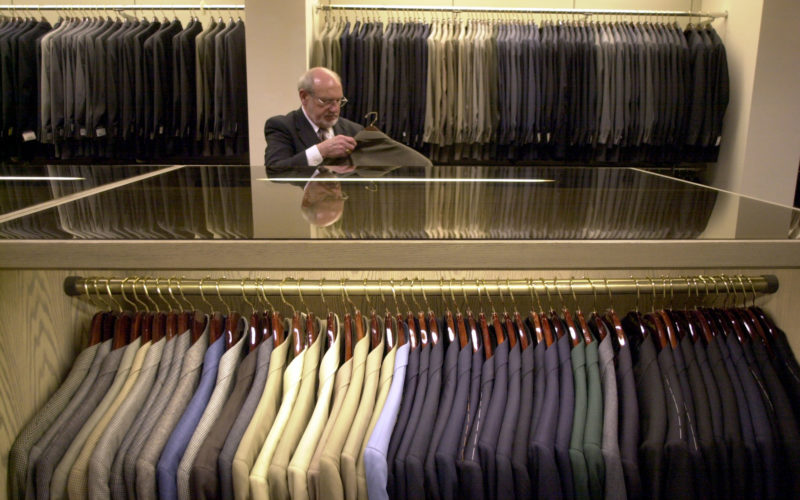Q. It seems we are moving away from the narrow, tight look back toward the center? Is that correct? What are the current trends in men’s business clothing, i.e. lapel size, tie size, and slacks fit?
A. You are right, the too-narrow, too-tight trend is on its way out. As I have written before, unlike women’s clothing which seems to change every thirty-five minutes, the swing of the fashion pendulum for men is marked in increments of several years. Today’s direction is moderate.
After years in the 90s of wearing generous (read: loose), oversized cuts (full-cut jackets, large lapels, wide ties, baggy trousers with pleats), the men’s fashion world switched gears and came under the influence of the modern designer, Thom Browne. He won Menswear Designer of the Year from the Council of Fashion Designers of America in 2006. His styles were all the rage; they were marked by an exaggerated close-to-the-body look: fitted and tight, but with sharp shoulders; very narrow lapels; and shrunken, too-short cropped trousers. To an eye that was used to fuller traditional cuts, his excessively tight tailoring came as a sharp (if not jarring) change.
While only the most fashion-forward dressers adopted these skinny looks, they did actually have a strong effect on how all suits were being cut. By 2010, even conservative manufacturers known for their classic styling began to change their design models somewhat: jackets and topcoats were slightly shorter, waists were more suppressed, and pleated trousers were abandoned in favor of flat-fronts. At its extreme, the Thom Browne look only really worked well for the young and the fit. An older “gentleman” looked – and often felt – ridiculous in this body-hugging styling. Traditional dressers found themselves caught in the dilemma of what to wear to look professional, and yet not “out-of-it.”
Now today, as you have noticed, the swing is headed in the other direction. The pendulum swing is to wider lapels. A major benefit to wearing regular size lapels is never looking out of style. The newer look is more of a return to basics, but slightly on the slim side. A current look includes natural shoulders with minimal padding, lapels of about 3 to 3½ inches in width, and correspondingly standard necktie widths in the 3¼ inch range. Some of today’s best looks are a mix of not-too-extreme styling, great-looking color mixing, and just a touch of flair. You might try a smart business look that calls just the right amount of attention to you: perhaps a trim navy blazer, slim well-pressed khakis, a blue-and-white Bengal striped French-cuff shirt, and a small neat-patterned tie in blue and yellow.
As to whether or not to wear pleated trousers, this is once again becoming an option. If a man likes the look and the comfort of pleats, he has a few options. Newer pleated trousers are much more flattering than the old, dated ones: they have fewer pleats (one or two, rather than two or three); the pleats are smaller and forward-facing instead of outward-facing (for a cleaner leg); the fabric is lighter in weight (appearing slimmer); and there is less of it. One more point about pleated pants: some used to say that pleated pants take cuffs, and flat-fronts take plain bottoms. I never agreed with this; nor do I now. I’ve always believed that trousers hang better, and look more refined/polished, with a cuff.
Even if you no longer wear a tie on a regular basis, on the occasions when you do, your ties should be in proportion with the width of your lapels. Today’s width is in the classic 3 to 3½ inch range. range.
Once again, we are seeing a shift back to a more tailored business look. Contemporary styling appears to be taking the middle road, choosing moderate lapels, classic tie widths, and straight trousers without too much of a break . . . instead of going too wide or too skinny.
Please send your men’s dress and grooming questions to MALE CALL: Lois.Fenton@prodigy.net









